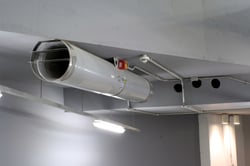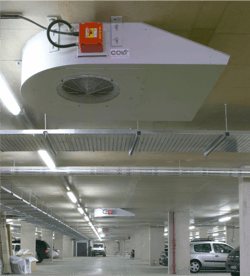Enclosed or underground parking areas normally require car park ventilation systems. Smoke control systems are needed to provide a means of clearing smoke from the car park during and after a fire. This will limit smoke temperatures and structural damage and inhibit smoke spread between floors. Smoke ventilation systems may be designed in addition to provide clear smoke-free access for fire fighters to tackle the seat of the fire or to protect means of escape from the car park. These ventilation systems are more complex and exceed the requirements of the Building Regulations. They are generally used as compensating features when other requirements of the regulations are not met.
Day-to-day ventilation is also needed to control build-up of vehicle exhaust fumes or spilled fuel when the facility is in general use. Acceptable day-to-day air quality is maintained by removing exhaust gases and pollutants produced by vehicles and by ensuring the constant movement of air so that there are no pockets of stagnant air. Invariably, smoke and fume ventilation are facilitated by the same dual-purpose system.

The two main system design approaches to smoke control in car parks
Smoke Clearance Systems
Smoke Control Systems
Smoke Clearance Systems
Smoke Clearance Systems are used to help aid the removal of smoke from the car park after the fire has been dealt with and offer no protections or help with escape to anyone who may be in the car park when the fire breaks out. They meet the requirements of Approved Document B and allow the fire service to clear smoke from an enclosed car park once the fire has been tackled.
- There are no prescribed objectives, just an air change rate for mechanical systems, or natural openings based on a percentage of the floor area, taking no account of potential fire size or fire location.
- Does NOT aid escape
- Where mechanical extract is employed, it is usually sized to provide 6 ACH to all levels for fume control and 10 ACH to the largest level for smoke clearance – to be drawing from the fire affected floor only
- Ducted systems can be used to distribute extract across the whole of the car park area, with extract points at high or low level
- Alternatively, jet fans (aka impulse or induction fans) can be used in lieu of ducting - these are generally located over roadways and laid out to ensure no stagnant areas.
- Where jet fans are used, the Car park is usually modelled using Computational Fluid Dynamics (CFD) to confirm good air movement throughout the space and that there are no stagnant areas. Systems based on air change rates can only offer smoke clearance.
Smoke Control Systems
As the name suggests, these systems are designed with a specific objective of controlling the movement and extract of smoke from the car park in mind. They offer added protection to anyone in the car park at the time of the fire and may be designed to aid in escape. They usually require additional extract over and above the basic clearance requirement.
These systems can be designed to:
- Aid escape and therefore extend safe escape distances
- Assist firefighting
- Control smoke as an alternative to compartmentation
- Trade-off against lobby ventilation in basement levels
In the UK, sprinklers are generally not required in car parks, except in certain applications, such as shopping centres or larger projects in London and Scotland – unless specifically specified in a fire engineering strategy
Smoke ventilation and control regulations in the UK
Throughout the UK there is legislation covering the car park ventilation requirements in new and refurbished buildings which needs to be satisfied.
The requirements vary slightly from country to country and are detailed in the documents mentioned below:
Smoke ventilation:
England and Wales: Approved Document B to the Building Regulations;
Scotland: Scottish Buildings Standards Technical Handbooks;
Northern Ireland: Technical Booklet E.
Day to day fume ventilation:
England and Wales: Approved Document F – Ventilation;
Scotland: Scottish Technical handbook - Non domestic. 2013 section 3.14
Northern Ireland: Technical Booklet K - Ventilation. 2012
Guidance in this blog is based upon English Building Regulations. Additional guidance is given in:
BS 7346-7: 2013 - “Components for Smoke and Heat Control Systems. Code of practice on functional recommendations and calculation methods for smoke and heat control systems for covered car parks”. This covers natural ventilation, ducted mechanical ventilation and impulse ventilation, and summarises the requirements of the Buildings Regulations for both smoke ventilation and ventilation air indoor air quality.
BS 9999:2008 – “Code of practice for fire safety in the design, management and use of buildings” BR 368 “Design Methodologies for Smoke and Heat Exhaust Ventilation” (BRE, 1999) SCA Guide “Design of Smoke Ventilation Systems for Loading Bays and Coach Parks - a guide for system designers” (FETA, 2010).
SCA Guide “CFD Modelling for Car Park Ventilation Systems – a guide for designers and regulators” (FETA, 2007). The guidance makes it easier for designers to validate their designs and for building control bodies to sanction them.
Colt car park ventilation and smoke control solutions
Colt’s team of designers have spent years developing industry-leading impulse ventilation systems for use in car parks.
Impulse ventilation is a method of providing ventilation in a car park by adding momentum to the air, by installing small unit fans under the ceiling to generate thrust. The impulse fans remove the need for large runs of ductwork as they push smoke and fumes to a central extract.
- A fan that has a throw of approximately 20 - 30m at full speed
- One fan covers approximately 400m²
- These figures can be significantly reduced by downstand beams
- Dimensions: Typically 2800mm long x 450mm deep
- 50N thrust, certified for use at 300°C for 1 hour (tested for 2 hours)
For more information about Jetstream, click here.
The Cyclone was developed specifically for use in larger car parks
There are two Sizes:
- Cyclone 100: 1457 long x 291mm deep – 100N thrust – one unit covers around 1000m² of car park
- Cyclone 50: 1206 long x 235mm deep – 50N thrust
- Certified for use at 300°C for 1 hour (tested for 2 hours)
- Effects of downstand beams reduced
- Could save 100mm of excavation per level
For more information about Cyclone, click here.
In some cases, extract fans may also be required. Colt can provide extract systems that meet the requirements for car parks (as below) :
Main Extract Fans Require:
- Temperature Rated to 300°C for 60 minutes.
- Back-up Power Supply.
- Minimum 2 fans at 50% each.
- Sound Attenuation
- Intake NR55
- Exhaust 55dB(A) at 3m (typical)s
To view our extract fans, click here.
 Conor Logan CEng FIMechE FCIBSE is Technical Director of Colt UK. Conor designs innovative smoke control and HVAC systems, represents Colt on many UK and EU standards committees and was Chairman of the Smoke Control Association for over 9 years.
Conor Logan CEng FIMechE FCIBSE is Technical Director of Colt UK. Conor designs innovative smoke control and HVAC systems, represents Colt on many UK and EU standards committees and was Chairman of the Smoke Control Association for over 9 years.




